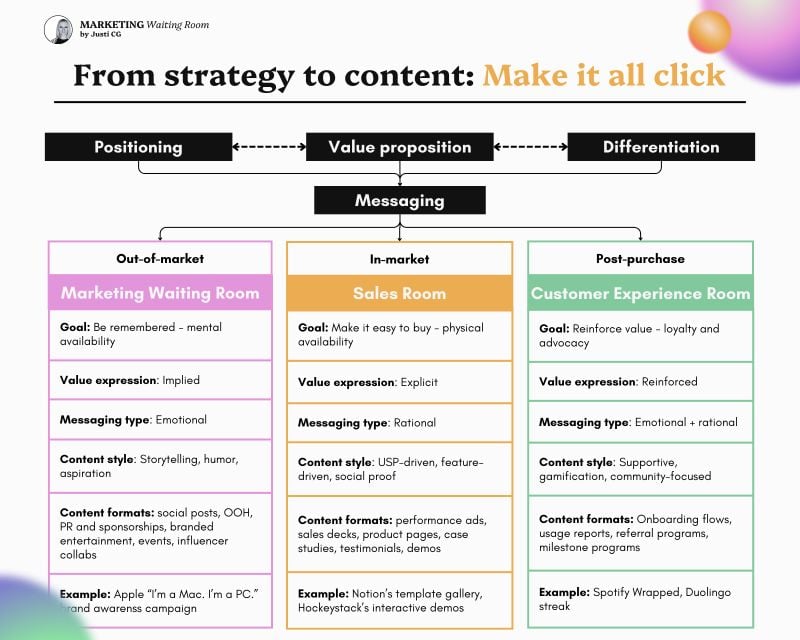Even if we all agree that the traditional marketing funnel is flawed and it’s time to bin it, we still have the problem of how to map our buyer’s journey. Justyna Ciecierska, Founder of the Marketing Waiting Room, has an interesting solution.
Why not think of your customer journey as interconnected waiting rooms? Spaces customers enter on their own volition and timeline and stay in depending on how well you’ve designed them.
I like this spatial approach. It acknowledges that purchase decisions happen on the buyer's timeline, not your timeline. They happen within the buyer's world, not your world as a business.
Waiting Rooms, Not Funnels
Justyna’s methodology requires us to think differently about how we’ve approached marketing and the marketing funnel in the past decade.
Unlike the artificial construction of a funnel, this spatial model maps to how your customers experience the buyer journey—a back-and-forth movement between different stages of commitment dependent on how their needs and timeframes change, rather than following a predetermined linear path.

Room #1: The Marketing Waiting Room
This is where your customers hang out before they actively seek solutions to their problems. It's an entry point that asks for little commitment from prospects. Your goal here is to build mental availability through emotional connections.
With the marketing waiting room, you are concerned with:
- Building emotional connection, not rational benefits
- Creating content that your prospects come across as they go about their everyday life
- Being present in conversations and spaces where your buyers already exist
Room #2: The Sales Waiting Room
This is where prospects go when something triggers their buying intent. Here, they need clear, factual information that helps them make decisions. This space is all about physical availability. In this room, you focus on:
- Presenting information designed for the rational brain
- Focusing on high-impact features identified in your empathy probing workshops (more on that below)
- Understanding that the buyer is now actively looking for information
- Making purchase easy once the buying trigger happens
Room #3: The Customer Experience Waiting Room
This room exists after purchase, where you deliver value, reinforce good feelings, and develop customer advocates. When you manage this well, you create loops that feed back into your marketing waiting room. Here, you focus on:
- Designing post-purchase experiences that reinforce the value you promised
- Focusing on adoption, usage, and engagement
- Creating opportunities for customers to advocate on your behalf
- Feeding these success stories back into the Marketing Waiting Room
Empathy Probing as a Way of Building Waiting Rooms
Your customers are simply living their lives, experiencing problems, and seeking solutions. And your job is to map their reality, not force them into your pre-conceived marketing model. For Justyna, empathy probing (also called a mind reader workshop) is a great tool for understanding how the buyer moves between the waiting rooms.
The process involves:
- Gather the marketing team, founders, sales, and any other customer-facing team.
- Ask them to embody a specific ideal client (e.g., 'From now on, everyone in this room is Katie, VP of Sales')
- Ask probing questions such as:
- Take me back to the day when you decided to buy this product. What happened that day?
- What happened a week before that?"
- How did that make you feel?"
- Who did you talk to?"
- Visualize everything on a timeline or a Miro Board to create a realistic map of the buyer journey
“When I do it, everyone is mind-blown. Everyone’s mindset shifts instantly,” she says. “It turns out that they know things that they had no idea they knew. Founders very often say ‘My gosh, I see how our marketing just doesn't make sense at all.’ Teams stop asking for generic tactics because they can see the actual journey their buyers take.”
What You'll Discover Through Empathy Probing
Through this process, you'll uncover:
- Category Entry Points: The situations that trigger someone to realize they have a problem and start looking for solutions. By asking questions like ‘what exactly makes people realize they have a problem, and how do they go about looking for a solution?’ you can identify multiple entry points and find recurring patterns.
- Emotional Triggers: ‘How did that make you feel?’ This question uncovers the emotional states your buyers experience. “What I find with this question is we literally find headlines for homepages or product pages, because people share things that speak to the emotional benefits buyers want out of a product,” Justyna explains.
- High-Impact Features: “Teams tend to speak a lot about a lot of different things, but most of these things are irrelevant,” she explains. The workshop helps identify ‘the things about the product that have the highest impact’ so you can prioritize those in your messaging.
Fin
The takeaway here is deals close when your buyers are ready, not when you are. As Justyna puts it, “You have to imagine that people are just walking around having their lives, and they might not or might just stumble upon you because more often than not, they're not actively looking for anything. You have to embed yourself into their world.”
Justyna’s buyer-focused approach means you’re more likely to:
- Create messaging that genuinely resonates with your ideal customers' emotional state
- Identify where and when to show up in their lives
- Understand the triggers that move people from awareness to action
- Design experiences that turn customers into advocates
This way, you earn the right to be part of their world.
What’s Next?
Ready to keep growing? We've got a couple of other resources you might find helpful, such as:
- Marketo's co-founder on how we fix revenue marketing
- How conversational AI is changing search and SEO
You should also subscribe to The CMO newsletter to stay on top of trends and get the latest tips, resources, and guides from our community of seasoned marketing leaders straight to your inbox.



